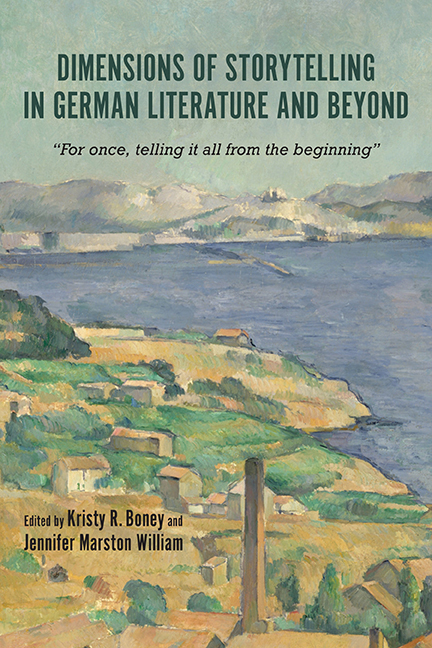 Dimensions of Storytelling in German Literature and Beyond
Dimensions of Storytelling in German Literature and Beyond Book contents
- Frontmatter
- Contents
- Acknowledgments
- Introduction: The Social, Political, and Personal Dimensions of Storytelling
- Part I Anna Seghers: A Missing Piece in the Canon of Modernist Storytellers
- 1 Anna Seghers in Heidelberg: The Formative Years
- 2 Who Is the Narrator? Anna Seghers's “The Excursion of the Dead Girls”: Narrative Mode and Cinematic Depiction
- 3 Anna Seghers's Rubble Literature, 1947–49
- 4 Anna Seghers and the Struggle to Tell Stories about the Nazi Past in the Early German Democratic Republic
- 5 Aufbauzeit or flaue Zeit? Anna Seghers's GDR Novels
- 6 The Time of Decision in Anna Seghers
- 7 Filling the Void with Stories: Anna Seghers's Conceptual Metaphors
- Part II Expressions of Modernity: Using Storytelling Unconventionally
- Part III The Personal Narrative: Storytelling in Acute Historical Moments
- Notes on the Contributors
- Index
2 - Who Is the Narrator? Anna Seghers's “The Excursion of the Dead Girls”: Narrative Mode and Cinematic Depiction
from Part I - Anna Seghers: A Missing Piece in the Canon of Modernist Storytellers
Published online by Cambridge University Press: 12 April 2019
- Frontmatter
- Contents
- Acknowledgments
- Introduction: The Social, Political, and Personal Dimensions of Storytelling
- Part I Anna Seghers: A Missing Piece in the Canon of Modernist Storytellers
- 1 Anna Seghers in Heidelberg: The Formative Years
- 2 Who Is the Narrator? Anna Seghers's “The Excursion of the Dead Girls”: Narrative Mode and Cinematic Depiction
- 3 Anna Seghers's Rubble Literature, 1947–49
- 4 Anna Seghers and the Struggle to Tell Stories about the Nazi Past in the Early German Democratic Republic
- 5 Aufbauzeit or flaue Zeit? Anna Seghers's GDR Novels
- 6 The Time of Decision in Anna Seghers
- 7 Filling the Void with Stories: Anna Seghers's Conceptual Metaphors
- Part II Expressions of Modernity: Using Storytelling Unconventionally
- Part III The Personal Narrative: Storytelling in Acute Historical Moments
- Notes on the Contributors
- Index
Summary
THE TITLE OF Anna Seghers's novella “The Excursion of the Dead Girls” sounds uncanny, as adventure and diversion are contrasted with the theme of death. This “masterpiece” is considered the author's only autobiographical work, one closely linked in theme and chronology to her life story. Because in this requiem for her female schoolmates, as well as her own parents, Seghers “reveals facts of her life, her youth, and the time of exile, nevertheless in the form of a narrative creation.” Doing “memory work” the author envisions things past, her youth and homeland (Heimat), while also mourning the lost promise of an idyll that was crushed by the events of history.
Who is the narrator and how is the story told? In this first-person narration there is generally a distinction between the narrating self and the experiencing self, contrasting the remembering I with the remembered I, Seghers at the time of her exile with the figure of Netty in her childhood. The treatment of the authentic and the autobiographical in Seghers not only recollects the excursion as an episode in her childhood, but also addresses different levels of time and facts of history up to the time of narration in the year 1943. This concerns actual events from Seghers's life story as well as from history, for instance references to Emperor Wilhelm II and the First World War; figures such as Hitler and Goebbels; the crossing of the Rhine by allied troops after the war, and later the re-occupation of the Rhineland by Hitler and the Wehrmacht. Additionally, the text refers to the Confessional Church (E 288) or “Bekennende Kirche,” which Seghers calls “Bekenntniskirche,” the Nazis’ doctrine of “racial defilement” and the concentration camps (E 290); and the People's Court (Volksgerichtshof: E 298). In addition, there are topographical references, such as to Petersau(e), an island in the Rhine, Amöneburg (E 300), and to Nonnenwerth, another island (E 301); and although her hometown, Mainz, is not mentioned by name, Seghers lists several streets such as Christhof Street (Christofstrasse), as well as the Christhof church, the late-Gothic church (St. Christoph), a ruin after it was destroyed in a bombing raid in 1942 (E 302).
- Type
- Chapter
- Information
- Dimensions of Storytelling in German Literature and Beyond“For once, telling it all from the beginning”, pp. 24 - 42Publisher: Boydell & BrewerPrint publication year: 2018
- 2
- Cited by


